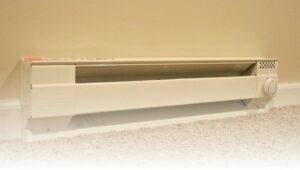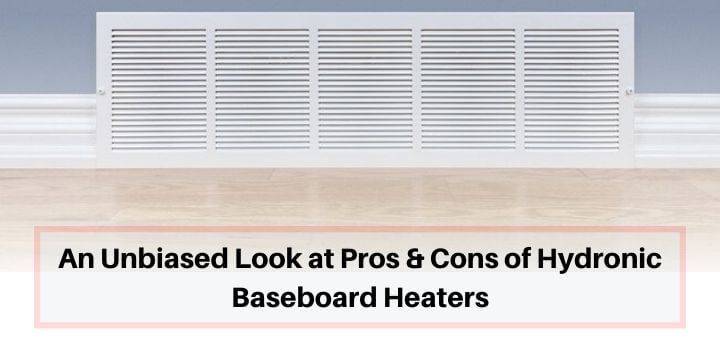Baseboard heaters, in case you didn’t know, are the primary source of heat for the vast majority of homeowners in North America and the Pacific Northwest who are looking to retrofit or construct a modern home.
This guide will define baseboard heating.
What Are The Pros And Cons Of Baseboard Heaters?
Baseboard heating refers to two separate kinds of heating systems; electric baseboard heaters and hydronic baseboard heaters.
Electric baseboard heaters are individual units that use electricity in the range of 120V to 240V to heat a house room by room or one specific zone through the natural convection of air. While hydronic baseboard heaters are central heating units that use a liquid medium to heat a room through the principle of radiation and airflow.
Unlike other alternative types of heating systems such as forced air systems, electric baseboard heaters and hydronic baseboard heaters are efficient. Close to 100% of the electric current that is supplied to the unit is transformed into heat.
Forced air systems are less efficient. Forced air systems are made of a furnace that blows heated air through a series of sheet metal ducts and requires expensive ductwork to run through walls, under floors, or above ceilings.
If you are searching for the best heating equipment one that offers a heating option in your home without the costly ductwork, then you might consider an electric baseboard heater and hydronic baseboard heater. Below are the pros and cons of electric baseboard heaters and hydronic baseboard heaters.
Electric Baseboard Heating Pros and Cons
Electric Baseboard heaters are typically mounted under a window on an exterior wall to promote convection of heat. Electric baseboard heaters work by taking in cool air from close to the floor.
The air is then projected up and pushed through heated fins on top of the heating unit into the room.
Electricity flows through the unit, creating heat and warming the room by passive convection as the heat naturally rises without the use of a fan
Pros
- Energy Efficiency.
Electric baseboard heaters have an energy efficiency of 100% because all the incoming electric energy is converted into heat. Innovative energy-regulating thermostats with smart features and the ability to be programmed, you can pre-set the unit so it warms your room at specific times i.e. when the temperature drops or when the temperature rises.
- Provide consistent warmth.
Electric baseboard heaters offer an effective way to heat your home or whenever you simply want to supplement an existing heating system to a particular spot that requires additional heating.
Baseboard heating creates a zoned system for comfort. A heating zone is a separately controlled area of your home that is adjusted independently from the rest of the house.
With an electrical baseboard heater, you’ll supply heat to a location where it’s needed directly. That’s why this option is an effective choice for basements, garages, and other spaces that typically require a supply of warmth.
- Costs less to install.
Ductwork is expensive to fabricate and install. Electric baseboard heaters are relatively simple to install in retrofit situations because there are no bulky ducts to run through walls.
You do not require ductwork to distribute the heat from room to room
- Save money
A good thermostat can save your energy budget by controlling the levels of heat received on the equipment itself. With an investment in a baseboard brand without an onboard thermostat, you can cut down on the electric bill to 30%.
With a programmable thermostat, you can automatically set the thermostat by dialing it, and programming it to a specific temperature for each unit in your home or business.
- Durable
The life expectancy of the unit is relatively longer. As long as they are properly maintained, baseboard heaters can last up to 20 or more years. [/su_list]
Related Post: Hydronic Baseboard Heaters
Cons
- Expensive to run.
With an electric Baseboard heater, you can expect an inflated energy bill. Besides the energy consumed in watching, laundry, taking showers, etc electric baseboard if not monitored will drive the electric bill through the roof.
- The thermostat can become faulty.
Some thermostats are not programmed properly. A faulty thermostat will display an incorrect temperature reading and fail to contain and regulate the heater.
- The thermostat can produce inconsistent heat.
The thermostat can form layers of dirt that insulate the heater causing it to block heat flow thereby making it record inconsistent readings. However, this can be easily cleaned with a vacuum and requires little additional maintenance.
Hydronic Baseboard Heaters Pros and Cons

A hydronic baseboard heater is a unit that uses water to heat a room and is mounted on a ground floor level in the room’s center heating pipes are installed beneath the floor with the intention of transferring and emitting heat across multiple rooms or zones. As a result, there is a constructed heating system.
Pros
- Save money
Well after the thermostat has been turned off, hydronic baseboard heaters can continue to radiate heat for an extended period of time. This is due to the asbestos tube element, which heats up and retains heat to keep the room temperature stable.
This makes them more energy-efficient, resulting in a 10% reduction in the final electricity bill, which is a significant saving.
- Warmth in your home on a regular basis.
A sealed heating tube element in hydronic baseboard heaters converts all-electric power into heat.
Because water runs the entire length of the heating system, the heat is distributed evenly rather than concentrated in a single hot spot.
The asbestos tube element and the large diameter reservoir, which maximizes the volume of heat transfer fluid, also help to maintain a stable water temperature even after the thermostat is turned off, ensuring a constant flow of warmth.
Though hydronic baseboard heaters were reputed to be slow in response, some manufacturers have come up with a thermostat that tracks the performance of the system that heats up faster and achieves a comfortable temperature.
- Operates quietly unlike the forced air system
If you’re standing next to the equipment, the noise can be deafening. Because of their fanless operation, hydronic baseboard heaters are quiet, clean, and provide comfortable heat, unlike traditional baseboard heaters. As a result, they are ideal for use in bedrooms and living rooms.
- High-quality material
The baseboard heating structure is implemented of strong steel and is available in a variety of colors. There is a baseboard heater in gold, cream, white, or black to match your home’s interior design.
Furthermore, hydronic baseboard heaters also include a front grille to keep foreign objects out of the heater’s internal area, and they are introduced in the United States, so now you can have confidence in the unit’s quality.
- The apparatus is secure.
A baked enamel element protects the hydronic baseboard heater from overheating. Hydronic baseboard heaters also work by circulating the liquid throughout the system rather than concentrating it in one spot.
Furthermore, they have a lower surface temperature than ordinary baseboards, guaranteeing that they are safe against surface burns. If you have children or pets, this is a safe option.
Baseboard heaters are significantly better for the environment. The heater doesn’t singe airborne particles within the air, dry it out, or push dusty air, pet hair dander, and other pollutants through a network of ancient vents as much as a standard baseboard because it operates without a fan. As a result, people who are allergic to them have no influence on their health.
Cons
- Cost to install and operate
With a Baseboard heater, you’ll need to install heating vents or make other upgrades to accommodate this system.
- Long time to heat
Without installing the new system which accelerates the speed at which the system heats up, the heater takes longer to heat up than other systems.
Also Read: Hydronic Baseboard Heater Comprehensive Guide
FAQS
How Can I Make My Baseboard Heating More Efficient?
In order to improve the efficiency of the baseboard heater, some elements must be addressed. Make sure that heat isn’t escaping through the walls, flooring, or insulation.
To avoid heat loss, invest in window efficiency and glass technology. It prevents heat loss by sealing the window.
The finest product to buy is a Silicone sealing strip silicone seal sticker adhesive suitable for door and door protection wall thermostats even heat the base and can be placed outside.
How Can I Lower My Electric Bill With Baseboard Heat?
Invest in the right way to decrease energy expenses. In addition to reducing your electricity bills by up to 30%, the smart thermometer provides better temperature with the underfloor heating system.
You can control the heating system through the app. are baseboard heaters efficient
Related Post:
- 30 Cozy Outdoor Kitchen Ideas You Can Try in Any Backyard - July 14, 2025
- 27 Cozy Dark Bedroom Inspiration Ideas for Warm and Relaxing - July 13, 2025
- Which Robot Lawn Mower Is Right for You? A Comparison of 6 Common Types - July 12, 2025

